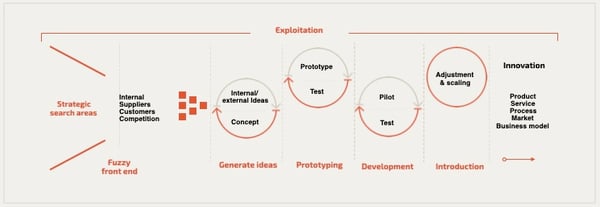7 Essential Steps for a Successful Innovation Process
A process in innovation management creates a clear framework for the development of something new. Learn which 7 steps your innovation process should consider.

The development of new products, services, or business models is not highly specific in terms of the process. An innovation project can be divided into certain phases that are repeated. Processes therefore play an important role in the structured and systematic implementation of projects in innovation management.
I will show you which 7 steps an innovation process should include and how they interact.
What is mostly forgotten in innovation processes
An innovation process is usually mapped out starting with idea conception and ending with market introduction. This is the weakness of most innovation team processes. Therefore, I would like to address this point right at the beginning before we look at the 7 steps of an innovation process in detail.
Define innovation management objectives
Do not first start the innovation process with idea conception, but rather with the defining of innovation objectives. The individual objectives should be clearly defined in harmony with the company strategy. In other words:
- What types of innovation are we pursuing?
- Where is the focus?
- How high does the level of innovation need to be?
- How many innovations are being pursued in which areas?
The choice of specific innovation goals marks the starting point of the innovation process and defines the strategies and process steps derived from it (idea generation, concept, development, etc.).
The last phase of the innovation process
Furthermore, the innovation process should not end upon market introduction – instead a perfectioning phase should be integrated, because numerous improvement measures are required in the first year following market introduction. Feedback from customers and users is specifically taken into account and integrated. The quality of the solution is thereby raised to the next level.
The 7 steps in the innovation process

Based on these premises, in addition to the innovation objectives as an overarching process component, 7 steps can essentially be identified in the innovation process. Between the individual steps, it always requires a decision (indicated by red arrows in the figure) to move to the next phase:
- Definition of strategic search areas
- Idea generation
- Concept phase
- Development
- Construction / implementation
- Market introduction
- Perfectioning
These 7 phases of an innovation process must be brought to life by your team, because not every procedure, fits every organization. "Bringing the process to life" means that you also need to think about the methods and structures behind it.
The successful trio: Process – Method – Structure
In addition to the process in the narrower sense, the innovation process also includes the innovation method and the innovation structure. Each phase in the innovation process (WHAT) therefore includes corresponding methods (HOW) and structures (WHO).
Example – "Concept phase" in innovation management:
- WHAT is being implemented: The conception phase is about devising appropriate concepts from the ideas previously gained.
- HOW implementation is performed: Various tools and methods can be used in the concept phase of the innovation process; e.g. the lead user method, service design, or a technology upgrade.
- WHO makes the decisions: In a functioning innovation process, it is clearly defined who in the company is responsible for each phase.
These three levels require appropriate coordination with each other to ensure the holistic design of the innovation process.
Innovation processes must move with the times
As with any other process in an organization, the innovation process must also evolve. During innovation projects, you and your innovation team may discover how you need to further align the process with your innovation management.
Likewise, new methods or tools (e.g. in idea management or for innovation metrics) can change the work in an innovation department. The possibilities offered by artificial intelligence (AI), for example, are changing how we solve innovation management tasks in the future. Increasing application scenarios for AI can be found in the innovation process.
Use of AI during the innovation process
A future-proof innovation process therefore itself moves with the times and reflects the use of new technologies. AI can influence the phases in the innovation process:
- AI-based virtual agents can guide you through the entire innovation process (or selected process phases).
- AI innovation tools can take data forecasts and make predictions. This reduces the manual effort in the innovation team.
- Specially trained AI tools can help with idea selection and decision making.
- Generative design can be used to quickly create different variations of drafts or prototypes.
- The creation of target group analyses or persona mapping will change. That's because AI can be used to search large volumes of dynamic data for similarity structures, cross-connections, and trends, and to create live personas.
Conclusion: The 7 phases of an innovation process
A holistic innovation process is aligned with the innovation objectives and purposefully integrates a phase of perfectioning, which serves to refine and adapt. Each phase should follow a structured process that establishes appropriate methods and decision-making responsibilities.
Constant evaluation at every stage of the innovation process enables resources to be deployed in the R&D and innovation team in a targeted manner and innovation activity to be focused on promising innovations. It is also a matter of keeping an eye on the changes in one's own work.
With an innovation process that fulfills a holistic approach, an important step for more innovative strength is fulfilled. However, those responsible for innovation must be aware that this only fulfills one aspect. In the following article, you will learn what framework you as a decision-maker need to create in order for your organization to become holistically innovative: House of Innovation: House of innovation: this is how CEOs make their company innovative.











